Lyons W.C. (ed.). Standard handbook of petroleum and natural gas engineering.2001- Volume 1
Подождите немного. Документ загружается.

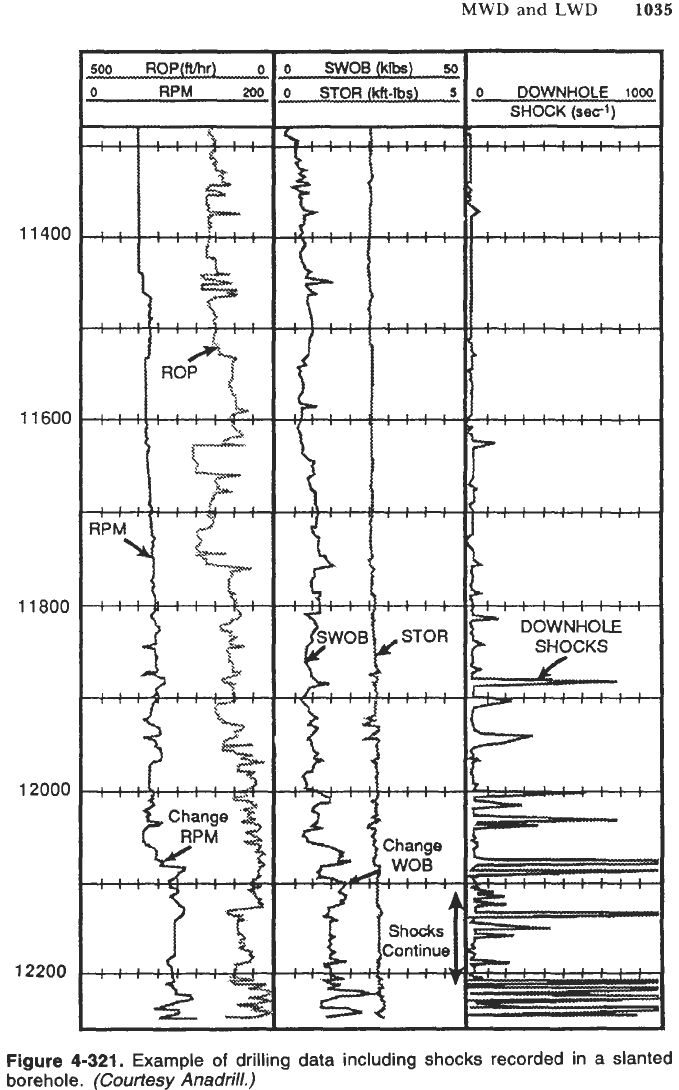
MWD
and
LWD
1035
11400
1 1
tioc
11800
12000
12200
500
ROP(fVhr)
o
0
RPM
260
Figure
4-321.
Example
of
drilling data including shocks recorded in a slanted
borehole.
(Courtesy
Anadrill.)
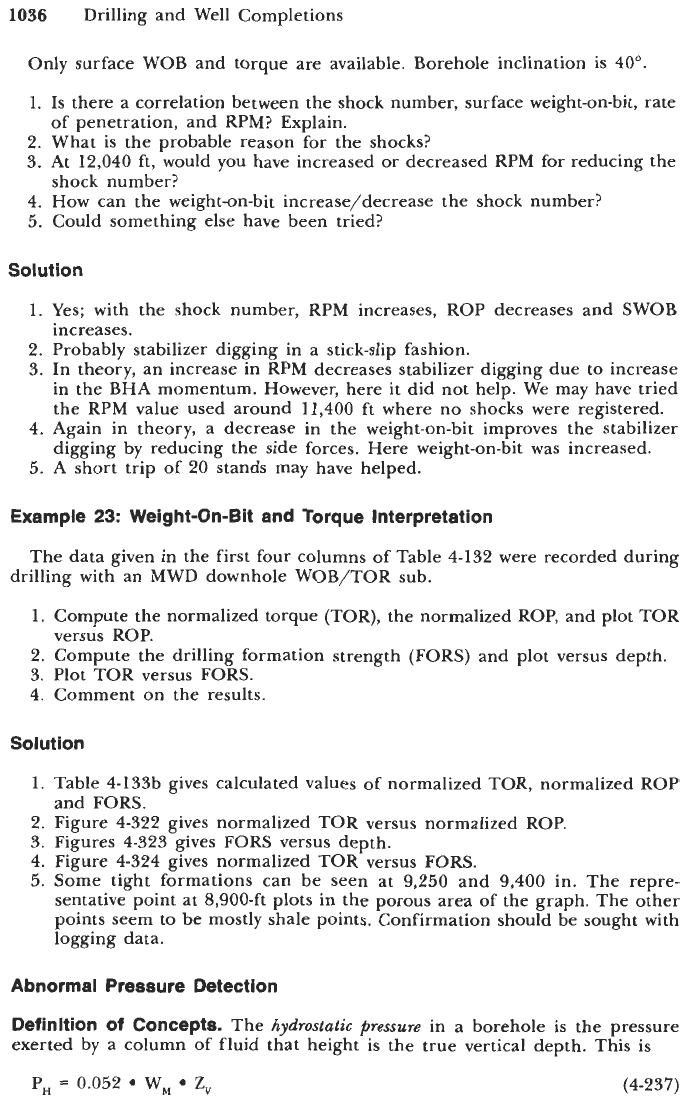
1036
Drilling and Well Completions
Only surface WOB and torque are available. Borehole inclination
is
40".
1.
Is there a correlation between the shock number, surface weight-on-bit, rate
2.
What is the probable reason for the shocks?
3.
At
12,040
ft, would you have increased or decreased
RPM
for reducing the
4.
How can the weight-on-bit increase/decrease the shock number?
5.
Could something else have been tried?
of penetration, and RPM? Explain.
shock number?
Solution
1.
Yes; with the shock number, RPM increases, ROP decreases and SWOB
2.
Probably stabilizer digging in a stick-slip fashion.
3.
In theory, an increase in RPM decreases stabilizer digging due to increase
in the BHA momentum. However, here it did not help. We may have tried
the RPM value used around
11,400
ft
where no shocks were registered.
4.
Again in theory, a decrease in the weight-on-bit improves the stabilizer
digging by reducing the side forces. Here weight-on-bit was increased.
5.
A short trip of
20
stands may have helped.
increases.
Example
23:
Weight-On-Bit and Torque Interpretation
The data given in the first four columns of Table
4-132
were recorded during
drilling with an MWD downhole WOB/TOR sub.
1.
Compute the normalized torque (TOR), the normalized ROP, and plot TOR
2.
Compute the drilling formation strength (FORS) and plot versus depth.
3.
Plot TOR versus FORS.
4.
Comment on the results.
versus ROP.
Solution
1.
Table
4-133b
gives calculated values of normalized TOR, normalized ROP
2.
Figure
4-322
gives normalized TOR versus normalized ROP.
3.
Figures
4-323
gives FORS versus depth.
4.
Figure
4-324
gives normalized TOR versus FORS.
5.
Some tight formations can be seen at
9,250
and
9,400
in. The repre-
sentative point at
8,900-ft
plots
in
the porous area of the graph. The other
points seem to be mostly shale points. Confirmation should be sought with
logging data.
and FORS.
Abnormal Pressure Detection
Definition
of
Concepts.
The
hydrostatic
pressure
in a borehole is the pressure
exerted by a column of fluid that height is the true vertical depth. This is
P,
=
0.052
W,
Zv
(4-237)
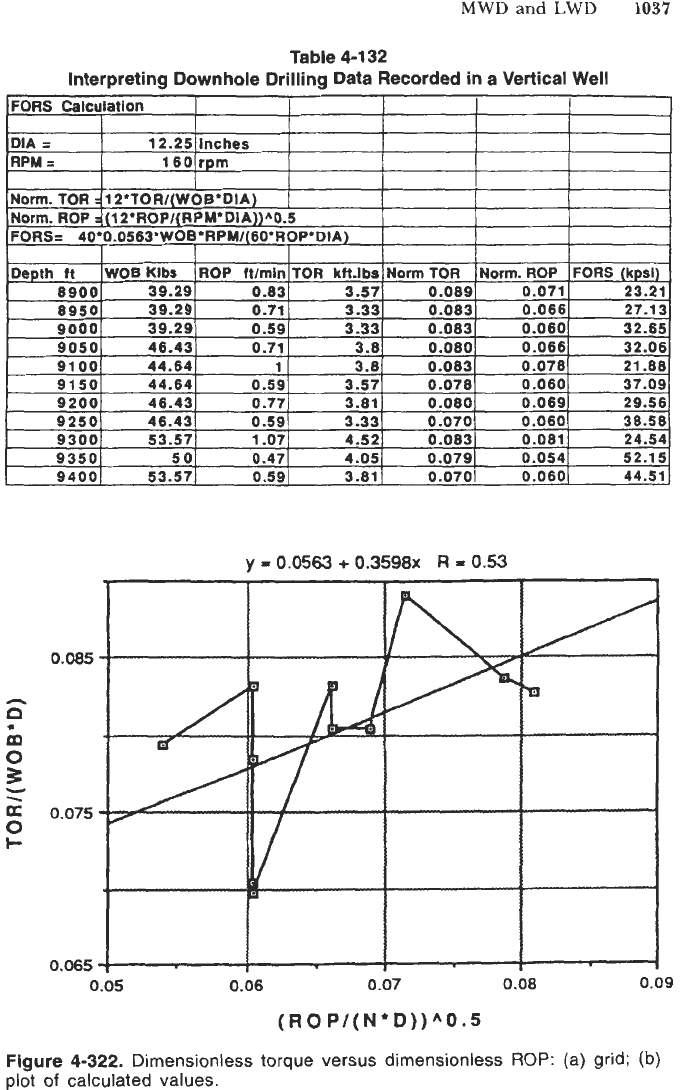
MWD
and
LWD
1037
A
n
m
0
B
U
0
I-
a
u
\
0.075
y
=
0.0563
+
0.3598~
R
0.53
0.085
0.065
.
0.05
0.06
0.07
0.08
0.09
(RO P/(
N*D))A0.5
Figure
4-322.
Dimensionless torque versus dimensionless
ROP:
(a) grid;
(b)
plot
of
calculated values.
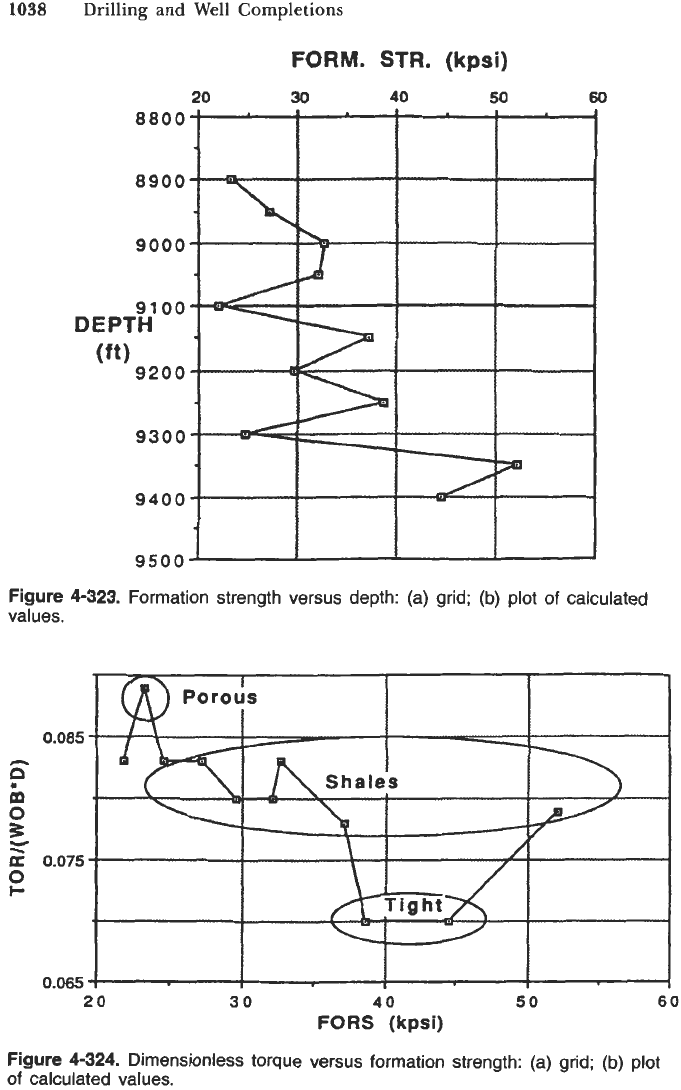
1038
Drilling and Well Completions
FORM.
STR.
(kpsi)
20
40
50
60
8800
8900
9000
9100
DEPTH
9200
(ft)
9300
9400
Figure
4-323.
Formation strength versus depth: (a) grid; (b) plot
of
calculated
values.
0.085
A
e
m
Y
2
0.075
E!
V.VW
I
I
20
30
40
50
60
FORS
(kpsi)
Figure
4-324.
Dimensionless torque versus formation strength: (a) grid; (b) plot
of
calculated values.
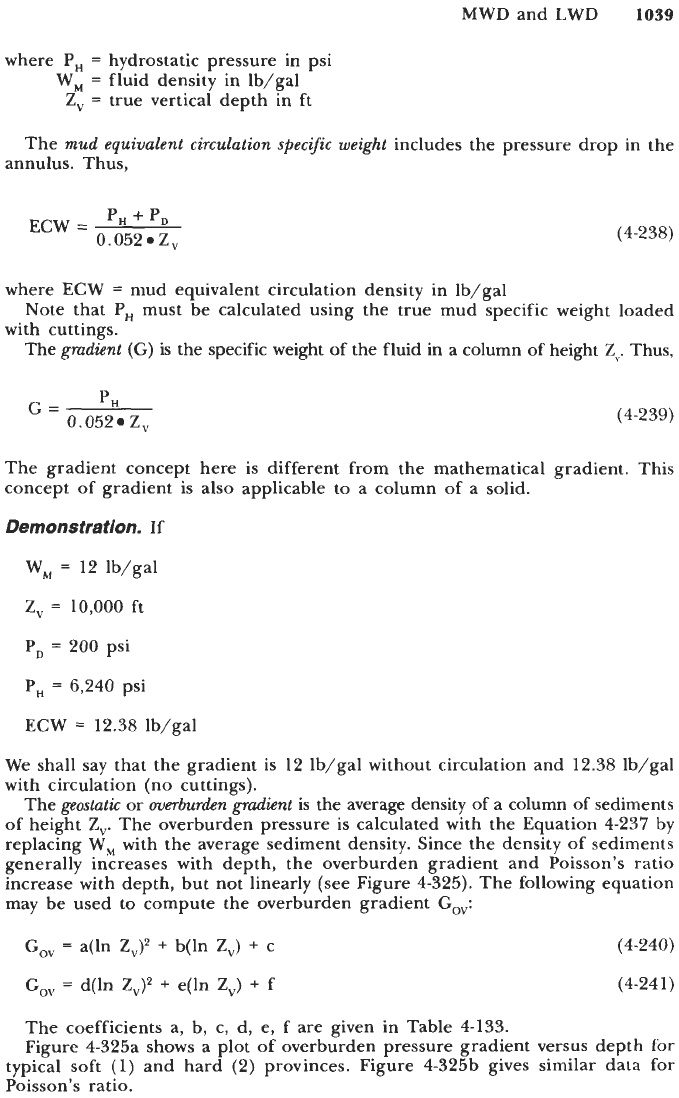
MWD
and
LWD
1039
where PH
=
hydrostatic pressure in psi
W,
=
fluid density in Ib/gal
Z,
=
true vertical depth in
ft
The
mud
equivalent circulation specific weight
includes the pressure drop in the
annulus. Thus,
(4-238)
where
ECW
=
mud equivalent circulation density in Ib/gal
with cuttings.
Note that
P,
must be calculated using the true mud specific weight loaded
The
gradient
(G)
is the specific weight of the fluid in a column of height
Zv.
Thus,
PH
G=
(4-239)
0.052
Z,
The gradient concept here is different from the mathematical gradient. This
concept of gradient is also applicable to a column of a solid.
Demonstration.
If
W,
=
12
lb/gal
z,
=
10,000
ft
PD
=
200
psi
P,
=
6,240
psi
ECW
=
12.38
Ib/gal
We shall say that the gradient is
12
lb/gal without circulation and
12.38
lb/gal
with circulation (no cuttings).
The
geostutic
or
overburden
gradient
is the average density
of
a column of sediments
of height
Z,.
The overburden pressure is calculated with the Equation
4-237
by
replacing
W,
with the average sediment density. Since the density
of
sediments
generally increases with depth, the overburden gradient and Poisson's ratio
increase with depth, but not linearly (see Figure
4-325).
The following equation
may be used to compute the overburden gradient
Go,:
G,
=
a(ln
2,)'
+
b(ln
Z,)
+
c
Go,
=
d(ln
2,)'
+
e(ln
Z,)
+
f
(4-240)
(4-241)
The coefficients a, b, c, d, e,
f
are given in Table
4-133.
Figure
4-325a
shows a plot
of
overburden pressure gradient versus depth
for
typical soft
(1)
and hard
(2)
provinces. Figure
4-32513
gives similar data for
Poisson's ratio.
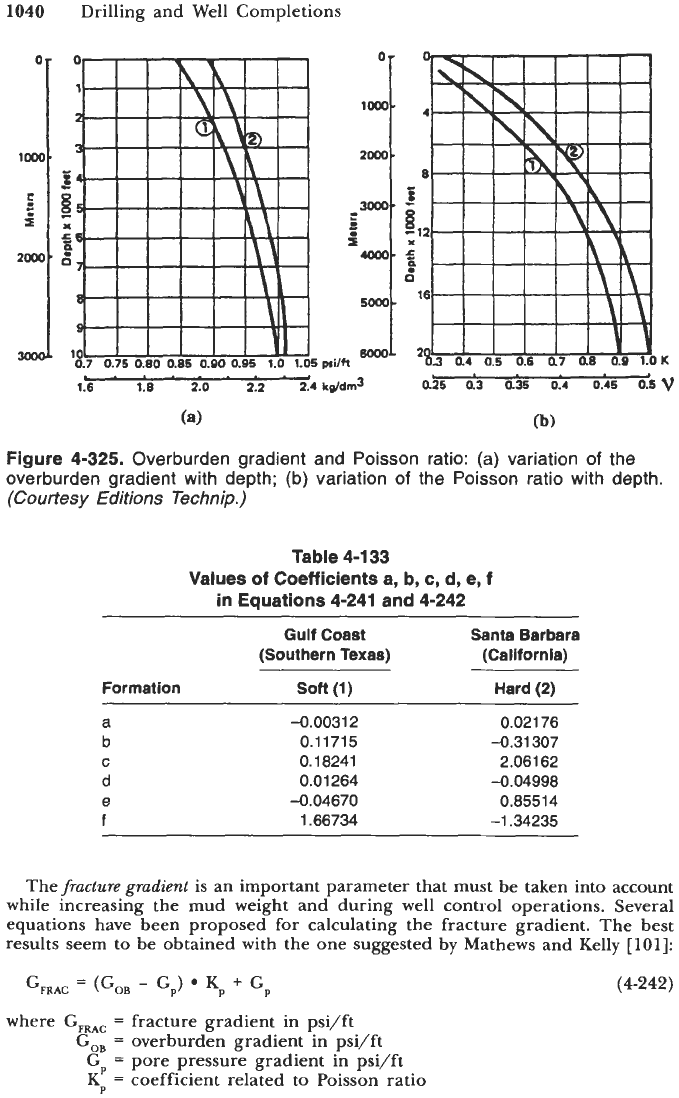
1040
Drilling and Well Completions
0-
1000.
2000.
3ooo.
I
x
*ooo.
5000
8ooo-
s.***-.-,
1.6
1.8
2.0
2.2 2.4
-
kpldrn3
ai5
0.3
a35
0.4 0.45
02
v
(a)
(b)
Figure 4-325.
Overburden gradient and Poisson ratio: (a) variation
of
the
overburden gradient with depth; (b) variation
of
the Poisson ratio with depth.
(Courtesy Editions Technip.)
Table 4-1 33
Values
of
Coefficients a, b, c, d, e,
f
in Equations 4-241 and 4-242
Gulf
Coast
Santa Barbara
(Southern Texas) (Callfornla)
Formation
soft
(1)
Hard
(2)
-0.00312
0.1 1715
0.18241
0.01264
1.66734
-0.04670
0.021 76
-0.31307
2.06162
-0.04998
0.85514
-1.34235
The
fracture
gradient
is an important parameter that must be taken into account
while increasing the mud weight and during well control operations. Several
equations have been proposed for calculating the fracture gradient. The best
results seem to be obtained with the one suggested by Mathews and Kelly
[loll:
where
G,,,
=
fracture gradient in psi/ft
Go,
=
overburden gradient in psi/ft
GP
=
pore pressure gradient in psi/ft
KP
=
coefficient related to Poisson ratio
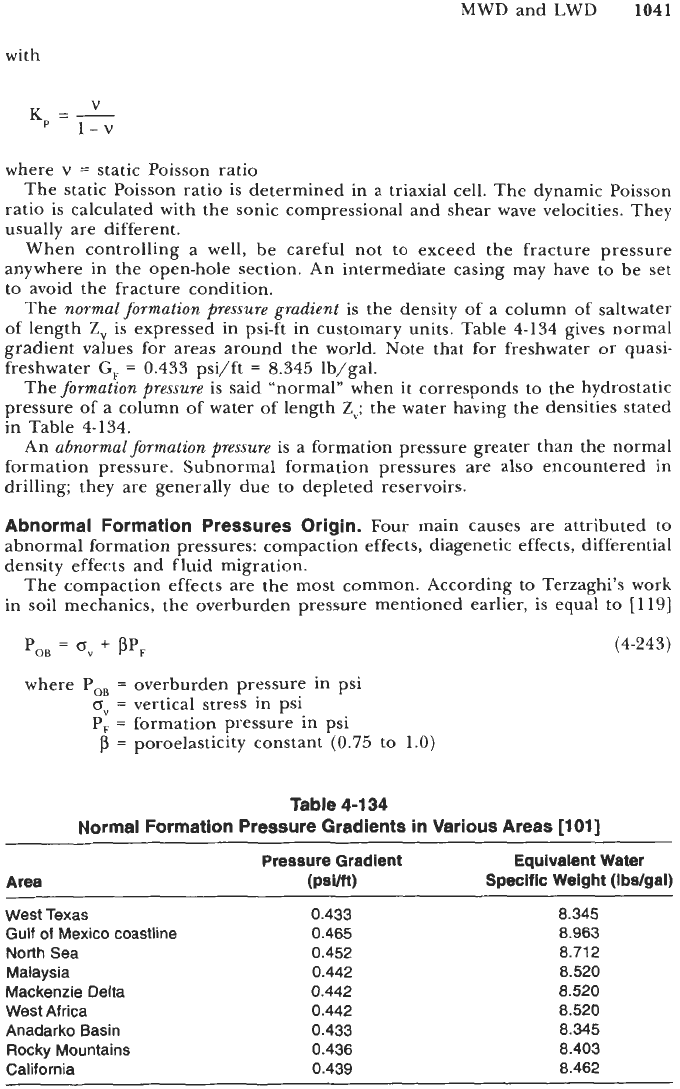
MWD
and
LWD
1041
with
where
v
=
static Poisson ratio
The static Poisson ratio
is
determined in a triaxial cell. The dynamic Poisson
ratio is calculated with the sonic compressional and shear wave velocities. They
usually are different.
When controlling a well, be careful not to exceed the fracture pressure
anywhere in the open-hole section.
An
intermediate casing may have to be set
to avoid the fracture condition.
The
normal formation pressure gradient
is the density of a column of saltwater
of
length
Z,
is
expressed in psi-ft in customary units. Table
4-134
gives normal
gradient values
for
areas around the world. Note that for freshwater or quasi-
freshwater
G,
=
0.433
psi/ft
=
8.345
lb/gal.
The
formation pressure
is said “normal” when
it
corresponds to the hydrostatic
pressure of a column of water of length
Z,,;
the water having the densities stated
in Table
4-134.
An
abnormal formation pressure
is a formation pressure greater than the normal
formation pressure. Subnormal formation pressures are also encountered in
drilling; they are generally due to depleted reservoirs.
Abnormal Formation Pressures Origin.
Four main causes are attributed
to
abnormal formation pressures: compaction effects, diagenetic effects, differential
density effects and fluid migration.
The compaction effects are the most common. According to Terzaghi’s work
in soil mechanics, the overburden pressure mentioned earlier,
is
equal to
11191
where
Po,
=
overburden pressure in psi
=
vertical stress in psi
P,
=
formation pressure in psi
p
=
poroelasticity constant
(0.75
to
1.0)
Table
4-134
I.ormal Formation Pressure Gradients in Various Areas
[loll
(4-243)
Area
Pressure Gradient Equivalent
Water
(PSW Specific
Weight
(Ibs/gal)
West
Texas
Gulf
of
Mexico coastline
North
Sea
Malaysia
Mackenzie Delta
West
Africa
Anadarko Basin
Rocky Mountains
California
0.433
0.465
0.452
0.442
0.442
0.442
0.433
0.436
0.439
8.345
8.963
8.712
8.520
8.520
8.520
8.345
8.403
8.462
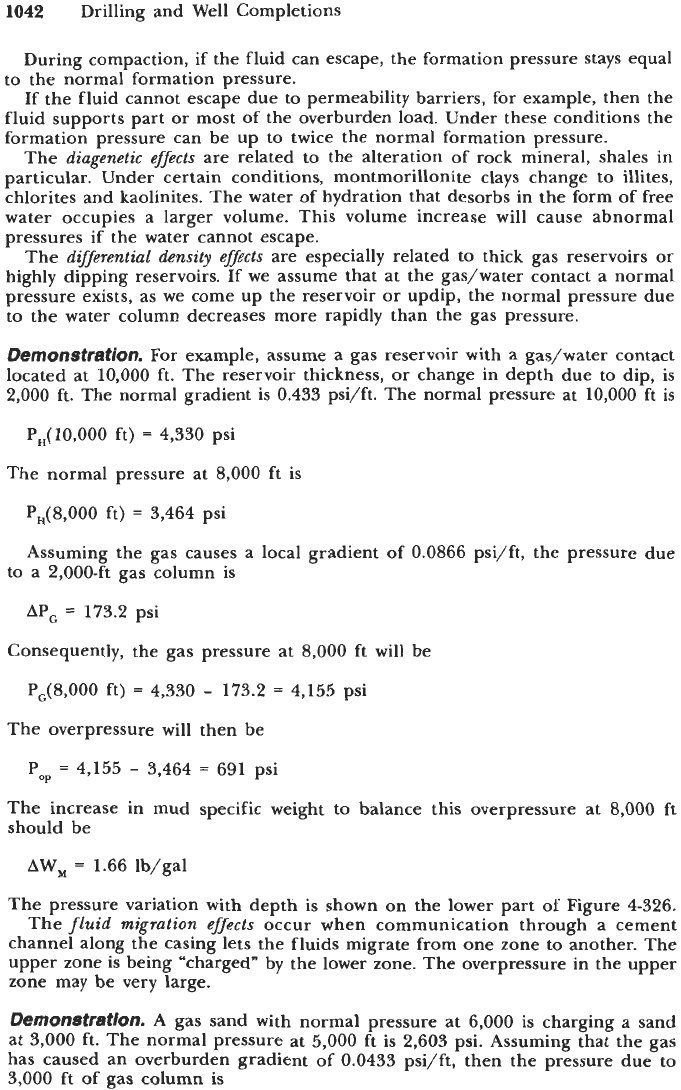
1042
Drilling and Well Completions
During compaction, if the fluid can escape, the formation pressure stays equal
to the normal formation pressure.
If the fluid cannot escape due to permeability barriers, for example, then the
fluid supports part
or
most of the overburden load. Under these conditions the
formation pressure can be up to twice the normal formation pressure.
The
diagenetic effects
are related to the alteration of rock mineral, shales in
particular. Under certain conditions, montmorillonite clays change to illites,
chlorites and kaolinites. The water of hydration that desorbs in the form of free
water occupies a larger volume. This volume increase will cause abnormal
pressures if the water cannot escape.
The
dvferential density effects
are especially related to thick gas reservoirs
or
highly dipping reservoirs. If we assume that at the gas/water contact a normal
pressure exists, as we come up the reservoir
or
updip, the normal pressure due
to the water column decreases more rapidly than the gas pressure.
Demonstration.
For
example, assume a gas reservoir with a gas/water contact
located at
10,000
ft. The reservoir thickness, or change in depth due to dip, is
2,000
ft. The normal gradient is
0.433
psi/ft. The normal pressure at
10,000
ft
is
P,(lO,OOO
ft)
=
4,330
psi
The normal pressure at
8,000
ft is
P,(8,000
ft)
=
3,464
psi
Assuming the gas causes a local gradient of
0.0866
psi/ft, the pressure due
to a 2,000-ft gas column is
APG
=
173.2
psi
Consequently, the gas pressure at
8,000
ft will be
PG(8,000
ft)
=
4,330
-
173.2
=
4,155
psi
The overpressure will then be
Pop
=
4,155
-
3,464
=
691
psi
The increase in mud specific weight to balance this overpressure at
8,000
ft
should be
AW,
=
1.66
lb/gal
The pressure variation with depth is shown on the lower part of Figure
4-326.
The
fluid migration effects
occur when communication through a cement
channel along the casing lets the fluids migrate from one zone to another. The
upper zone is being "charged" by the lower zone. The overpressure in the upper
zone may be very large.
Demonstration.
A gas sand with normal pressure at
6,000
is charging a sand
at
3,000
ft. The normal pressure at
5,000
ft is
2,603
psi. Assuming that the gas
has caused an overburden gradient
of
0.0433
psi/ft, then the pressure due to
3,000
ft of gas column is
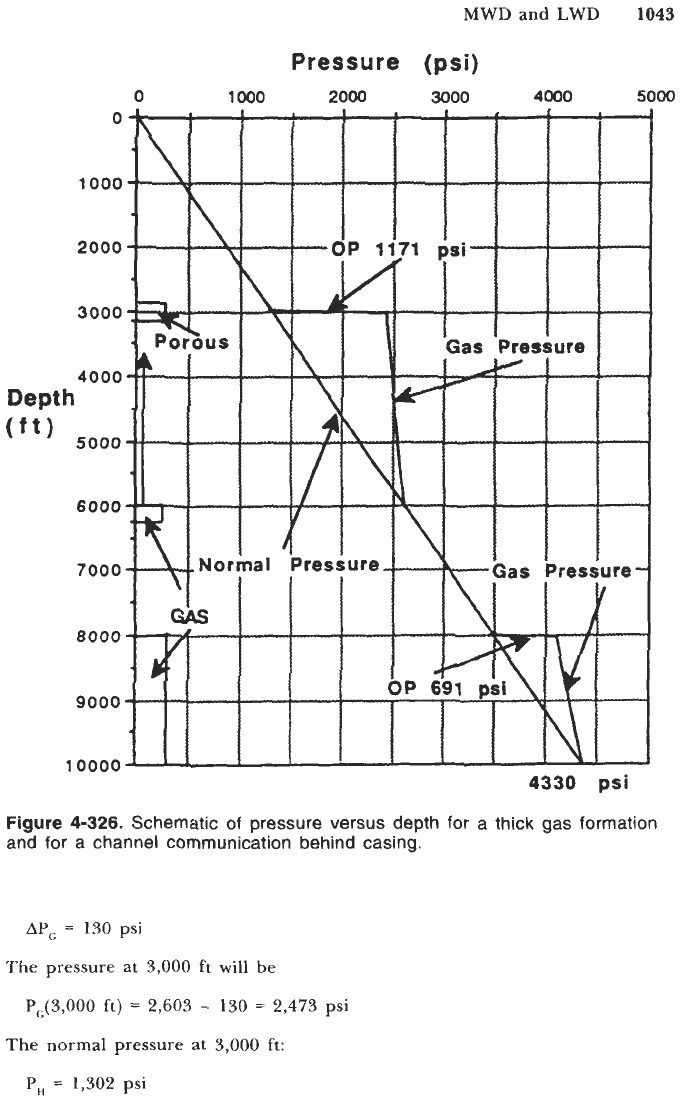
MWD
and
LWD
1043
Pressure
(psi)
0
1000
2000
3000
4000
SO00
Figure
4-326.
Schematic of pressure versus depth for
a
thick
gas
formation
and for a channel communication behind casing.
APG
=
130
psi
The pressure
at
3,000
ft
will
be
PJ3,OOO
ft)
=
2,603
-
130
=
2,473
psi
The
normal
pressure
at
3,000
ft:
P,
=
1,302
psi
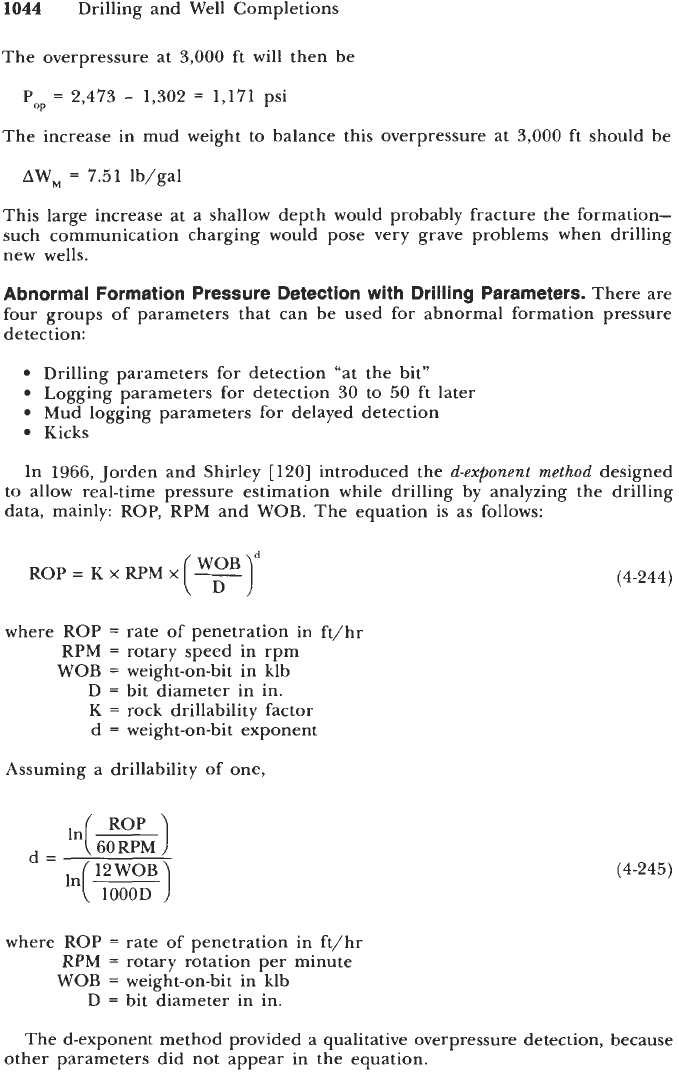
1044
Drilling and Well Completions
The overpressure at
3,000
ft will then be
P
=
2,473
-
1,302
=
1,171
psi
OP
The increase in mud weight to balance this overpressure at
3,000
ft
should be
AWM
=
7.51
lb/gal
This large increase at a shallow depth would probably fracture the formation-
such communication charging would pose very grave problems when drilling
new wells.
Abnormal Formation Pressure Detection with Drilling Parameters.
There are
four groups of parameters that can be used for abnormal formation pressure
detection:
Drilling parameters for detection “at the bit”
Logging parameters for detection
30
to
50
ft later
Mud logging parameters for delayed detection
Kicks
In
1966,
Jorden and Shirley
[120]
introduced the
d-exponent method
designed
to allow real-time pressure estimation while drilling by analyzing the drilling
data, mainly: ROP, RPM and WOB. The equation is as follows:
ROPzKxRPMX
-
(w:B)”
where ROP
=
rate of penetration in ft/hr
RPM
=
rotary speed in rpm
WOB
=
weight-on-bit in klb
D
=
bit diameter in in.
K
=
rock drillability factor
d
=
weight-on-bit exponent
Assuming a drillability of one,
where ROP
=
rate of penetration in ft/hr
RPM
=
rotary rotation per minute
WOB
=
weight-on-bit in klb
D
=
bit diameter in in.
(4-244)
(4-245)
The d-exponent method provided a qualitative overpressure detection, because
other parameters did not appear in the equation.
